Critical Friends: Collaborating as Writers Transcript
Teacher [in class]: I just want to check in with you. We're ready to do some collaborating as writers.
Teacher [in interview]: Hi. This is David Olio from South Windsor. This is my AP literature class and we, today are examining text through collaboration as writers. Our focus novel's Tony Morrison's Beloved. Students had wrestled with a passage and completed a piece of writing. Ultimately, the purpose is for the writer to make decisions to revise their own work.
Teacher [in class]: What we're going to be doing, of course is working with our critical friends group - which means writer as fly on the wall. You're outside of the conversation. And that we actually have a conversation. I use critical friends as a peer review model. This means that the writer remains in silent. The writer is not a part of the conversation whatsoever simply a note-taker or what we call a witness.
[00:01:09.07]
Teacher [in interview]: Here are steps today to have collaborative discussions around work - I'd like you to first select a writer's work. Can you do that right now? One writer, quick.
Teacher [in class]: The conversation then emerges with the other students in the group in examining that writer's piece of writing and having a conversation beginning first with the warm fuzzies. What just gives you the goose bumps and makes you just sigh with joy.
Teacher [in interview]: We ask them to do that by examining evidence in that student's text. This is that transition from reader to writer.
Teacher [in class]: I'll just start off as a model, and, oh, I love that first sentence. What could you say to me?
Student: What about it do you like?
Teacher [in class]: What about it do you like? He's gonna ask for more from me. So, we have that dialogue and we deepen it. Then, provide some feedback - some of the cooler feedback. In other words, what questions do you have. What do you see as perhaps some areas in which the writer might be able to refocus on when he or she is getting back into the revision stage. Then, once we've had that conversation, we want to invite the writer back in - they can have clarifying questions, get a chance to even disagree and say, "I don't think so, I think I'm gonna go this way and you can have some final conversation. Then, you're the writer, you get to judge the validity of what people are saying. Okay, let's take a quick look before we get started. These are two potential areas that you could provide warm and cool feedback about. The first one is focused terse first and second sentences. Your topic sentence or question goes directly into that evidence. Avoid repeating the same word. The other thing is - this is the second thing - elaborate on your evidence. I see often that we use the evidence and then we talk generally about it as opposed to zooming back in on a word. And of course, during warm and cool feedback, there's also your choice. What really does move you or what does bother you about the piece of writing. All right. Group, go ahead and jump in and enjoy some great pieces of writing.
[00:03:27.02]
Student: I would just advise, maybe instead of saying in figurative language - once you're getting in from the general saying she manipulates figurative language, once you get down a little bit more specific you should specify what type of figurative language - personification or...
Teacher [in class]: Igor, just a quick question. So, who's the writer in your group?
Student: Seth.
Teacher [in class]: You and Luke are having this - he just gets to listen.
Student: Sorry.
Teacher [in class]: I know. It's easy to forget.
Teacher [in interview]: Students will say, "I absolutely understand how to do this." You'll turn your head and the next thing, they're speaking to the writer.
Teacher [in class]: What I'm trying to do is have a conversation between you two without her to examine and argue back and forth and she can listen to that argument and be able to then draw her own conclusions.
Teacher [in interview]: It really enables a writer to hear their work in another way.
Teacher [in class]: So, why don't you start back with the warm. What specifically did you love about this? You can't talk. You're flies on the wall - can't talk.
Student: I love her word choice. There are a lot of great verbs throughout this. It sounded very sophisticated because of that. The way that it seemed kind of taken aback was the fact that she had so many run on sentences that...
Teacher [in interview]: There were lots of things but students tend to jump to what they want to change. They have a difficulty in appreciating some style. Especially from another student.
[00:04:57.13]
Student: The only thing that confused me was when she mentioned Paul D. because I feel like that distracted from her feelings of isolation by bringing in another character.
Teacher [in interview]: A student raised the question about why the writer would be including Paul D. when she was originally writing about Setha's isolation.
Teacher [in class]: Do you think that she could bring in that character with a transitional phrase?
Student: Yeah.
Teacher [in class]: What would you suggest?
Teacher [in interview]: This, of course raised the question of a transition. which we began to discuss.
Teacher [in class]: Give me a transitional word.
Student: I like "despite."
Teacher [in class]: [Reading] "Despite Morrison in this passage placing the first person narration..." That would really change that.
Student: Yeah, just by adding that in, it would make more sense to distinguish the two different areas of isolation.
Teacher [in interview]: A transition actually changed, for the readers, the whole meaning of the passage.
Student: I didn't even realize that using just a transition word could just completely reshape this.
Teacher [in class]: Isn't that cool?
Student: Yeah.
Teacher [in interview]: Once the small group has offered their feedback the writer is invited back in to talk about their work.
Student 1: You say it doesn't connect when I talk about Paul D., but I put him in their to talk about how she was coming out of her silence by connecting with someone, finally.
Student 2: Oh! That's what you meant.
Teacher [in interview]: The writer is encouraged to ask clarifying questions: agree, disagree and otherwise argue because invariably, the writer has been sitting on his or her hands, dying to enter the conversation.
Student: I tried to make the connection between the text and then the meaning of the text so I wanted to say in images, she created separation as a metaphor for social separation. I guess I'll just make that more clear that...
Teacher [in interview]: They want to say, "but didn't you see this?" Or, "I really meant to say that." However, this is really the crux to critical friends. It forces a student an understanding that their text is indeed a text. What they have are words they must choose them carefully and wisely because those word choices have impact.
[00:07:18.17]
Teacher [in class]: you're experimenting with vocabulary.
Student: Like which ones sounded the best, when you're reading something - after you read it, it's like that sounded really good.
Teacher [in class]: That's right, you experiment with them but you gotta look em up to make sure that you know with those - you've got it open. Outstanding!
Student: Shamelessly using a thesaurus.
Teacher [in class]: Outstanding!
Teacher [in interview]: He has learned, as a student, to experiment with word choice. And therefore be able to become a better writer as he writes.
Student: Maybe I could change the order and say that the despising herself is being echoed in the physical action...
Teacher [in interview]: Because writing is revising - it's essential to have a strategy that compels students to apply the process of revision. Critical Friends is a strategy that accomplishes that.
[00:08:09.29]
Teacher [in class}: So many great conversations going on today.
Teacher [in interview]: Now, students will go really sit down after class, think about that piece of writing and revise and ready for submission.
Teacher [in class]: I would like to end by saying thank you today, you did a fantastic job...
Teacher [in interview]: Students are also asked to revise a piece of writing that they had worked on earlier in the week. Remember, we're going to extend because we haven't done this kind of work with number three. You’re gonna have to go back and take your skills that you developed today, this week - go back into number three, do the best you can with that one and submit both of them. And hopefully...
Teacher [in interview]: The design is to ask students to apply their learning from the collaboration today to yet another piece of writing that they have completed. As a result, students should have the skill in paragraph writing, in close writing analysis that they can embed in longer pieces of writing from short essays into longer papers.
[00:09:26.10]
END

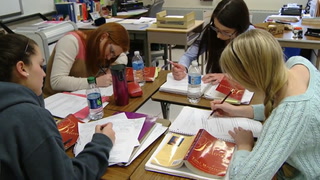
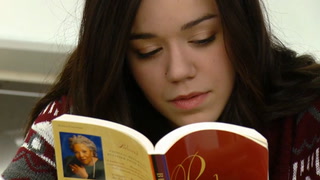
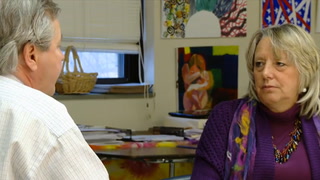

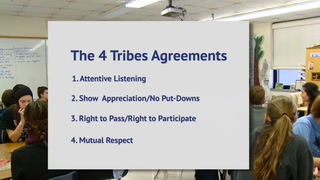
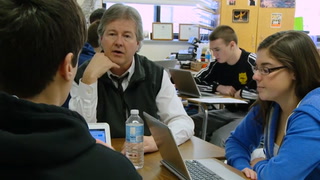
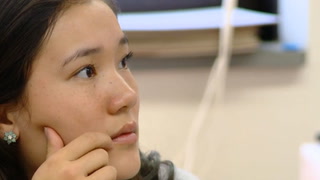
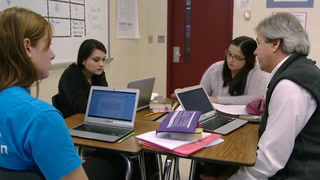








14 Comments
Tiffany Bills Oct 8, 2018 12:35pm
I'm using this strategy, but am not sure what to have the reader do during the reading portion. Just work on his/her story?
TraceyAnn Smith May 19, 2016 2:43pm
Kevin Rigsby Aug 17, 2015 12:29pm
Carla Hegler Jun 16, 2015 4:33pm
Stephanie Lindberg Mar 5, 2015 7:32pm